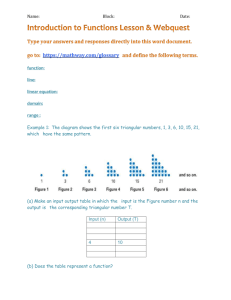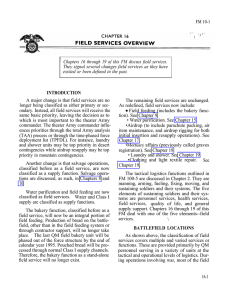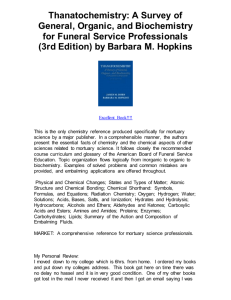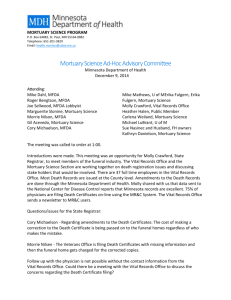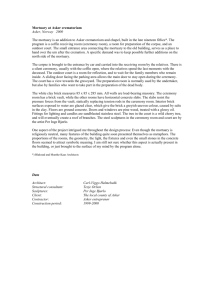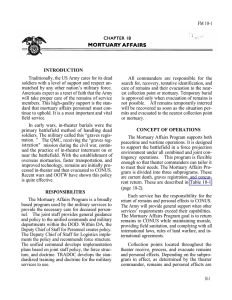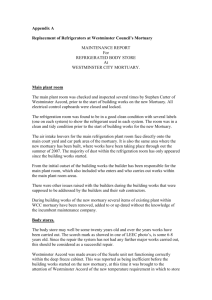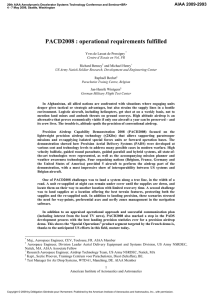FM 100-10 Field Services ANNEX F
advertisement
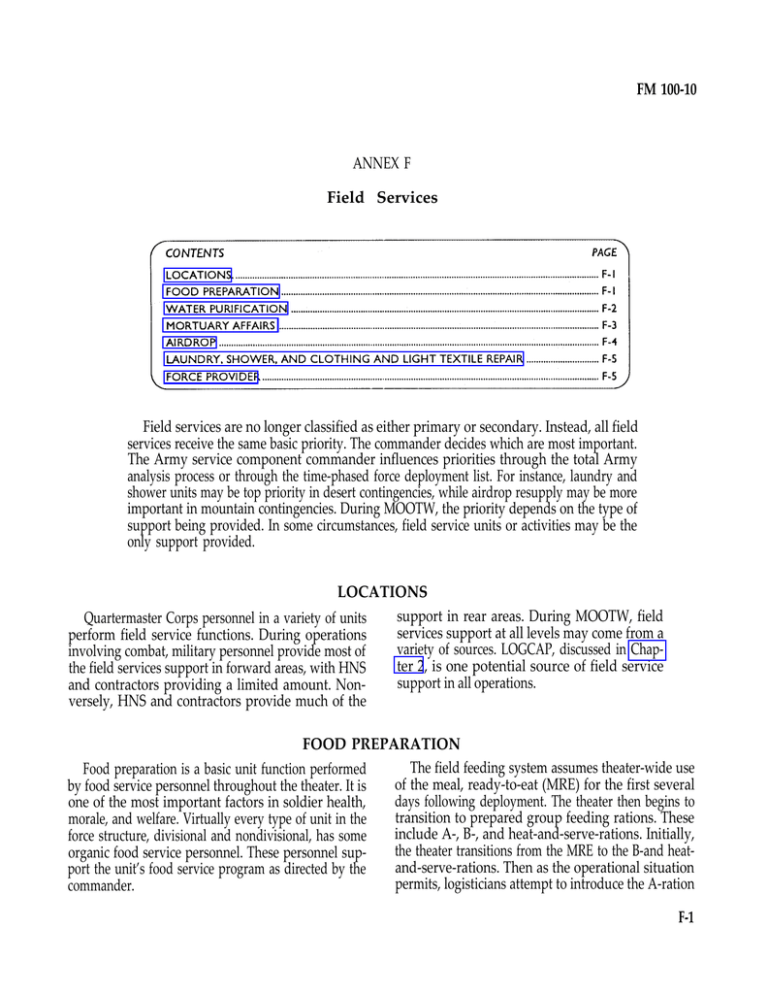
FM 100-10 ANNEX F Field Services Field services are no longer classified as either primary or secondary. Instead, all field services receive the same basic priority. The commander decides which are most important. The Army service component commander influences priorities through the total Army analysis process or through the time-phased force deployment list. For instance, laundry and shower units may be top priority in desert contingencies, while airdrop resupply may be more important in mountain contingencies. During MOOTW, the priority depends on the type of support being provided. In some circumstances, field service units or activities may be the only support provided. LOCATIONS Quartermaster Corps personnel in a variety of units perform field service functions. During operations involving combat, military personnel provide most of the field services support in forward areas, with HNS and contractors providing a limited amount. Nonversely, HNS and contractors provide much of the support in rear areas. During MOOTW, field services support at all levels may come from a variety of sources. LOGCAP, discussed in Chapter 2, is one potential source of field service support in all operations. FOOD PREPARATION The field feeding system assumes theater-wide use Food preparation is a basic unit function performed of the meal, ready-to-eat (MRE) for the first several by food service personnel throughout the theater. It is days following deployment. The theater then begins to one of the most important factors in soldier health, transition to prepared group feeding rations. These morale, and welfare. Virtually every type of unit in the include A-, B-, and heat-and-serve-rations. Initially, force structure, divisional and nondivisional, has some the theater transitions from the MRE to the B-and heatorganic food service personnel. These personnel supand-serve-rations. Then as the operational situation port the unit’s food service program as directed by the permits, logisticians attempt to introduce the A-ration commander. F-1 FM 100-10 (fresh foods) into the theater. This requires extensive logistics expansion since it requires refrigerated storage and distribution equipment along with a capability to make or acquire ice for unit storage. The feeding standard is to provide soldiers at all echelons three quality meals. The meals fed depend on the prevailing conditions. Disposal of garbage is important to avoid leaving signature trails. See FM 10-1 for details. The bakery function, previously classified as a field service, is now an integral portion of field feeding. Production of bread on the battlefield, other than in the field feeding system or through contractor support, will no longer take place. Normal Class I supply channels will handle pouched bread. The bakery function is no longer a stand-alone field service. WATER PURIFICATION Water is an essential commodity. It is necessary for sanitation, food preparation, construction, and decontamination. Support activities, such as helicopter maintenance and operation of medical facilities, consume large volumes of water. It is critical to the individual soldier. Classification of the water function is somewhat different from other commodities; it is both a field service and a supply function. Water purification is a field service. Quartermaster supply units normally perform purification in conjunction with storage and distribution of potable water--a supply function. GS and DS water units do not store or distribute nonpotable water. Therefore, nonpotable water requirements (for example, water for construction, laundry, and showers) are the responsibility of the user. Water supply units perform routine testing. However, water quality monitoring is primarily the responsibility of the preventive medicine personnel of the medical command or corps. The command surgeon performs tests associated with water source approval, monitors potable water, and interprets the water testing results. Each service provides its own water resource support. However, the Army or another service provides support beyond a service’s capability in a joint operation. AR 700-136 details the responsibilities of Army elements for water support. The Corps of Engineers plays a major role in providing water to our forces. The engineers, through the Topogmphical Engineering Center, develop and maintain an automated data base for the rapid retrieval of F-2 water source related data. The engineers are also responsible for finding subsurface water; drilling wells; and constructing, repairing, maintaining, and operating permanent and semipermanent water facilities. In addition, they assist water units with site preparation when required. The quantity of water required depends on the regional climate and the type and scope of operations. Temperate, tropic, and arctic environments normally have enough fresh surface and subsurface water sources to meet raw water requirements for the force. In arid regions, provision of water takes on significantly greater dimensions. Soldiers must drink more water. Water requirements are significantly greater in rear areas, where there is heavy demand for water for aircraft and vehicle washing, medical treatment, laundry and shower facilities, and construction projects. Planners may easily underestimate water requirements for enemy prisoners of war. They must consider the potential absence of water capability in enemy units and the requirement for on-site sanitation, shower, delousing, and medical support for in-coming prisoners. Since water is a critical commodity in arid regions, managers must strictly control its use. Commanders set up a priority and allocation system. Because of the scarcity of potable water in some contingency areas, water support equipment is prepositioned afloat. This allows for initial support to a contingency force. Additional water equipment is available in CONUS depots to sustain operations. Most of this equipment is packaged for tactical transportability. Its configuration allows for throughput to the user with minimal handling in the theater of operations. FM 100-10 In nonarid regions, DS supply units in the DISCOM and at EAD provide water purification and water supply support on an area basis. During the early stages of a contingency operation, the DISCOM may provide water for nondivisional units until additional logistics units arrive. In arid regions where sufficient water sources are not available, EAD units establish GS water systems. GS water purification elements supplement the capabilities of the DS elements. GS water supply companies set up and operate bulk storage and distribution facilities or terminals. Tactical water distribution teams can be assigned to water supply companies to augment capabilities for distribution via hose line. These GS water supply companies distribute potable water to DS supply units for nondivisional customers and to the divisions. Hose lines, pipelines, or trucks move potable water to forward areas. Division capabilities are augmented with storage and distribution systems to provide for one day of supply on the ground in both the DSA and BSA. Truck companies augmented with semitrailer-mounted fabric tanks provide line-haul of water at the tactical level. MORTUARY AFFAIRS The Mortuary Affairs Program is a broadly based military program to provide for the necessary care and disposition of deceased personnel. It supports both war and MOOTW. The program can have a direct and sudden impact on the morale of soldiers and the American public. It provides flexible support in a forceprojection environment. Each service has the responsibility for the return of remains and personal effects to CONUS. The Army is designated as the executive agent for the Joint Mortuary Affairs Program. It maintains a Central Joint Mortuary Affairs Office (CJMAO) and provides general support to other services when their requirements exceed their capabilities. The Mortuary Affairs Program is divided into three subprograms: The Current Death Program operates around the world in peacetime and outside of areas of conflict during military operations. It may also continue in areas of conflict depending on the CSS and tactical situation. It provides mortuary supplies and associated services for permanent disposition of remains and personal effects of persons for whom the Army is or becomes responsible. The Graves Registration Program provides for search, recovery, initial identification, and temporary burial of deceased personnel in temporary burial sites. Temporary burials are a last resort, and the theater commander must authorize them. It also provides for the care and maintenance of burial sites and for the handling and disposition of personal effects. The Concurrent Return Program is a combination of the Current Death and Graves Registration Programs. This program provides for the search, recovery, and evacuation of remains to collection points and further evacuation to a mortuary. It provides for identification and preparation of remains in a mortuary and shipment to a final destination as directed by the next of kin. The joint staff provides general guidance and policy to the unified commands and military departments within DOD. Within DA, the Deputy Chief of Staff for Personnel has overall responsibility for the Mortuary Affairs Program and manages peacetime operations. The Deputy Chief of Staff for Logistics is responsible for field operations during time of war. The US Army Training and Doctrine Command develops the standardized training and doctrine for the military services. The unified commander develops implementation plans based on the joint staff policy and doctrine. At the unified command level, a joint mortuary affairs office provides the commander with guidance, coordination capability, and the staff supervision for all mortuary affairs. All commanders are responsible for the search, recovery, tentative identification, care, and evacuation of remains to the nearest collection point or mortuary. Each division has a small mortuary affairs element (two to three personnel) organic to the DISCOM. They F-3 FM 100-10 train division personnel to perform initial search, recovery, identification, and evacuation of human remains and personal effects. During hostilities, the mortuary affairs personnel organic to the division operate collection points. This procedure continues until the division receives additional mortuary affairs personnel or a mortuary affairs unit. A mortuary affairs unit assigned to the corps support command supports nondivisional units on an area basis. This unit operates collection points throughout the corps, division, and brigade areas. These points receive remains from the maneuver units, assist and conduct search and recovery operations, and arrange for the evacuation of remains to a mortuary or temporary burial site. Mortuary affairs units operate theater collection points, evacuation points, and personal effects depots. Mortuary affairs personnel initially process remains in theater. Then they arrange to evacuate remains and personal effects, usually by air, to a CONUS point of entry mortuary. CONUS port of entry mortuaries provide a positive identification of the remains and prepare them for release in accordance with the desires of the next of kin. Recent wars and MOOTW have shown this policy is quite effective. When directed by the unified commander, mortuary affairs units establish cemeteries and provide for temporary interment of remains. Mortuary affairs units may also operate in-theater mortuaries, but they require personnel and equipment augmentation or host nation support for identification of remains and embalming. To further our national policy of returning all US service personnel who die in any theater of operation to the next of kin, new decontamination procedures are under development. Plans call for the establishment of a task organized mortuary affairs decontamination collection point. Personnel set up and operate a point near areas that have a large number of contaminated remains. For other cases, collection point teams may decontaminate remains. FM 10-63 and JP 4-06 have more information on decontamination of remains and mortuary affairs in general. AIRDROP Support of airdrop equipment and systems includes parachute packing, air item maintenance, and rigging supplies and equipment. The airdrop function supports both airborne insertions and airdrop/airland resupply. Airborne insertions involve the delivery of an airborne fighting force, along with its supplies and equipment, to an objective area by parachute. FM 100-27 covers airborne insertions in detail. Airdrop resupply operations apply to all Army forces. The airdrop function supports the movement of personnel, equipment, and supplies. It is a vital link in the distribution system; it provides the capability of supplying the force even when land LOCs have been disrupted. It adds flexibility to the distribution system. AMC manages most airdrop equipment and systems (ADES) at the national strategic level. It includes the NICP and national maintenance point for ADES. At the operational level, there are two types of airdrop support units. A heavy airdrop supply company provides reinforcing support to corps level airdrop supply F-4 companies. In addition, an airdrop equipment repair and supply company provides supply and maintenance support to airdrop supply companies in the corps (other than the airborne corps) and at echelons above corps. A light airdrop supply company provides airdrop/ airland resupply support to the corps. In addition, it provides personnel parachute support to units such as long range surveillance units. If the corps cannot support an airdrop request, it passes the request to the airdrop supply company at EAC. Most of the supplies used for rigging by the airdrop supply company come directly from the strategic level, bypassing the airdrop equipment repair and supply company at EAC. The EAC ADES repair and supply company provides ADES maintenance support for the corps light airdrop supply company. The airborne corps has an organic airdrop capability. If it cannot meet the airdrop resupply requirement, it forwards the requirement to the supporting airdrop unit at EAC. FM 100-10 Airdrop resupply support must be flexible. Certain contingencies may require airdrop resupply support from the beginning of hostilities. However, the requisite airdrop support structure is not likely to be in place due to deployment priorities. In such cases, the operational level commander should consider having a portion of the supporting airdrop supply company deploy to the DOD depot responsible for supply support to the contingency area. If forces require airdrop resupply prior to the deployment of the airdrop support units to the theater, the units may rig supplies for airdrop at the DOD depot. Supplies are then flown directly to the airdrop location. This would require adaptation of the request procedures outlined in FM 100-27. LAUNDRY, SHOWER, AND CLOTHING AND LIGHT TEXTILE REPAIR Clean, serviceable clothing and showers are essential for hygiene and morale purposes. During peacetime, shower, laundry, and clothing repair are normally provided through fixed facilities or field expedient methods for short duration exercises. During war and MOOTW, they are provided as far forward as the brigade area. The goal is to provide soldiers with one shower and up to 15 pounds of laundered clothing each week. Soldiers receive their own clothing from a tactical laundry within 24 hours. Responsibilities at the strategic level are basically those involving provisioning. Clothing replacement, a Class II function, is covered in Annex A. Forces receive support from a combination of units, HNS, and contractor. In rear areas, HNS and contractors may provide much of this support. LOGCAP offers considerable capability during the early deployment stages. A laundry and renovation company may provide GS laundry capability. The capability to repair medium- and heavy-weight textiles is in selected maintenance units. These elements repair canvas and fabrics used on vehicles and items such as seat covers, tarpaulins, cargo covers, and swim barriers. A field service company provides direct support at the tactical level. The company has the modular capability of sending small teams as far forward as desired by the supported commander. The unit provides one shower for each soldier each week. However, other sources can help to reach the goal of two showers for each soldier each week. Other sources could include field expediency methods, small unit shower equipment, HNS, or contract services. The field service company has equipment to provide mass delousing operations under the direction and supervision of medical personnel. The laundry and shower function does not include laundry decontamination support. Detailed troop decontamination of chemical and biological agents does not require showers. Radiation decontamination, however, may require showers. If soldiers use chemical defense equipment against fallout, they do not need showers. If they do not, then contamination lodges in soldiers’ hair and on skin. Then only showers can remove the contamination. Planners must ensure control of the runoff from these showers since it is contaminated. FM 3-5 has decontamination procedures. The new chemical protective clothing keeps its protective qualities after laundering. Once exposed to contamination, it must be disposed of under theater policies. FORCE PROVIDER The Army’s Force Provider is a modular system, principally designed to provide the front-line soldier with a brief respite from the rigors of a combat environment. Each module will provide life support for up to 550 soldiers. It will include environmentally controlled billeting; modern latrines, showers and kitchens; MWR facilities; and complete laundry support. Additionally, the module infrastructure will incorporate a complete F-5 FM 100-10 water distribution/disposal system and power grid. Modules can be complexed to provide contiguous support to a brigade-sized force. The cadre for operating the Force Provider will consist of Force Provider companies. However, they require augmentation to effectively operate the system. Force Provider will F-6 also have potential for use as a staging area during deployment/redeployment, a reconstitution site, and an intermediate staging base. It is also ideally suited for supporting MOOTW, particularly disaster assistance and humanitarian aid operations.
